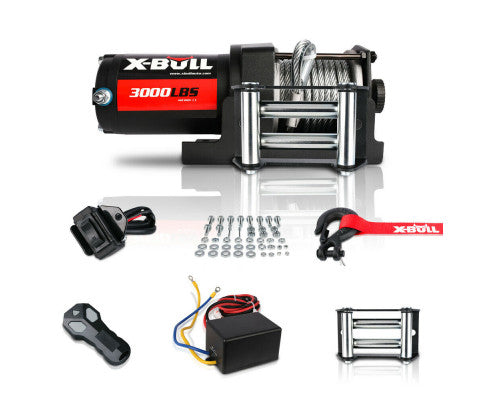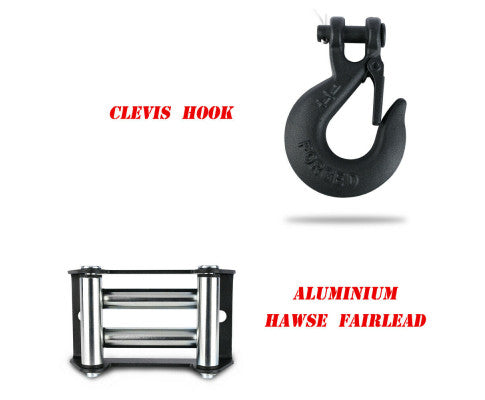sales@tecnotools.com.au
sales@tecnotools.com.au
Call us: 0433 734 100

Off-road adventures can be thrilling, but they also come with their fair share of challenges. Whether you're traversing rugged terrain or tackling tricky inclines, having the right equipment can make all the difference. One such essential tool is a 12V car winch. In this blog post, we'll delve into everything you need to know about these powerful devices, from selecting the right one for your vehicle to using it effectively in various situations.
A 12V car winch is a mechanical device used primarily in off-road vehicles to pull heavy loads or vehicles out of challenging situations. It operates using a 12-volt DC (direct current) power source, typically provided by the vehicle's electrical system.

The winch consists of several key components, including a motor, gearbox, drum or spool, and a length of cable or synthetic rope. When activated, the motor turns the drum, winding the cable or rope onto it. This action creates a pulling force that can be used to tow vehicles, move heavy objects, or recover stuck vehicles by anchoring the winch to a stable point such as a tree or another vehicle.
12V car winches are commonly used in off-road vehicles such as trucks, SUVs, and ATVs, as well as in various industrial and recreational applications where a portable and powerful pulling mechanism is needed. They come in a range of sizes and capacities to suit different vehicles and towing needs.
Choosing the right winch for your vehicle is crucial to ensure effective performance and safety during off-road adventures. Here are some key factors to consider:
Vehicle Weight and Size: The winch's pulling capacity should match or exceed the weight of your vehicle. Consider the gross vehicle weight rating (GVWR) to determine the minimum pulling capacity required.
Type of Vehicle: Different vehicles may have different winch mounting options and requirements. Ensure compatibility with your vehicle's make and model.
Intended Use: Determine the primary purpose of the winch. Is it for self-recovery, assisting others, or other purposes? This will help determine the appropriate capacity, line speed, and other features.
Pulling Capacity: Choose a winch with a pulling capacity suitable for your vehicle's weight and the potential load it may need to pull. It's generally recommended to select a winch with a capacity at least 1.5 times the vehicle's weight for optimal performance.
Line Speed: Consider the winch's line speed, which determines how quickly it can pull in the cable. Faster line speed may be preferable for quick recoveries, but it may sacrifice pulling power.
Cable Type: Decide between steel cable and synthetic rope. Steel cable is durable but heavier, while synthetic rope is lighter and safer but may require more maintenance.
Waterproofing and Durability: Choose a winch with waterproof or water-resistant construction to withstand exposure to mud, water, and other elements commonly encountered off-road. Look for features such as sealed motor and gearbox to ensure durability.
Mounting Options: Consider where and how the winch will be mounted on your vehicle. Front or rear mounting options are common, but ensure there is adequate space and mounting hardware available.
Brand Reputation and Reviews: Research winch brands and models to find reliable and well-reviewed options. Consider factors such as warranty, customer support, and aftermarket accessories availability.
Budget: Determine your budget for purchasing and installing a winch. While quality winches may come at a higher price, investing in a reliable and durable winch is essential for safety and performance.
By carefully considering these factors and choosing a winch that meets your vehicle's specifications and intended use, you can ensure a reliable and effective tool for off-road adventures.
Installing and setting up a car winch requires careful attention to detail to ensure proper functionality and safety. Here's a step-by-step guide to help you through the process:
Choose a Suitable Mounting Location: Determine whether you'll mount the winch on the front or rear of your vehicle. Consider factors such as accessibility, weight distribution, and available space.
Prepare the Mounting Surface: Ensure the mounting surface is strong and capable of supporting the weight of the winch and the load it will pull. If necessary, reinforce the mounting surface with additional brackets or plates.
Attach the Winch to the Mounting Surface: Use the appropriate mounting hardware (bolts, nuts, washers) to secure the winch to the mounting surface. Follow the manufacturer's instructions for proper bolt torque specifications.
Wire the Winch: Connect the winch's power cables to the vehicle's electrical system. Run the cables through the vehicle's body to protect them from damage and ensure a clean installation. Follow the winch manufacturer's wiring diagram and instructions carefully.
Install a Winch Solenoid or Control Box: Depending on the winch model, you may need to install a solenoid or control box to manage the electrical connections and control the winch operation. Mount the solenoid or control box in a secure location near the winch.
Connect the Winch Controller: If your winch comes with a handheld or wireless controller, connect it to the solenoid or control box according to the manufacturer's instructions. Ensure the controller is easily accessible from the driver's seat.
Test the Winch: Before putting the winch into service, test its operation to ensure everything is functioning correctly. Verify that the winch pulls smoothly and that the cable or rope spools properly onto the drum.
Adjust the Winch Clutch and Brake: Some winches feature a clutch and brake system to control the spooling of the cable or rope. Adjust these components according to the manufacturer's instructions to ensure proper operation.
Secure the Winch Cable or Rope: Attach the winch cable or synthetic rope to the winch drum securely using the provided hook or clevis. Ensure the attachment is tight and properly seated to prevent slippage during use.
Perform a Final Inspection: Double-check all connections, mounting hardware, and wiring to ensure everything is secure and properly installed. Look for any signs of wear or damage that may affect the winch's performance.
By following these steps and referring to the winch manufacturer's instructions, you can install and set up a car winch safely and effectively, ensuring reliable performance during off-road adventures and vehicle recoveries. If you're not confident in your ability to install the winch yourself, consider seeking assistance from a professional mechanic or installer.
Mastering basic winching techniques is essential for safe and effective vehicle recovery during off-road adventures. Here are some fundamental winching techniques to keep in mind:
Assess the Situation: Before attempting to winch your vehicle, assess the terrain, obstacles, and the condition of your vehicle. Determine the safest and most effective winching approach.
Secure Anchor Points: Identify sturdy anchor points to which you can safely attach the winch cable or rope. Suitable anchor points may include trees, rock formations, or other vehicles. Ensure the anchor points are capable of withstanding the pulling force exerted by the winch.
Use a Snatch Block: If a straight-line pull is not possible or if you need to change the direction of pull, use a snatch block. Attach the snatch block to a stable anchor point and run the winch cable or rope through it to redirect the pulling force.
Engage the Winch: Engage the winch motor and begin spooling out the cable or rope. Ensure the cable is free from knots or tangles before attaching it to the anchor point.
Attach the Winch Cable or Rope: Securely attach the winch cable or synthetic rope to the anchor point using a suitable attachment method, such as a D-ring or clevis hook. Double-check the connection to ensure it is tight and properly seated.
Tension the Cable or Rope: Slowly begin winching in the cable or rope, maintaining tension throughout the process. Avoid sudden jerks or abrupt movements that could strain the winch or compromise safety.
Monitor the Winch Operation: Keep an eye on the winch operation and the tension in the cable or rope. Stop winching immediately if you notice any signs of strain, overheating, or abnormal noises.
Assist with Recovery: As the winch pulls the vehicle, assist with the recovery by driving or guiding the vehicle in the desired direction. Coordinate with a spotter to ensure safe and effective vehicle movement.
Release Tension Safely: Once the vehicle is successfully recovered, release tension from the winch cable or rope slowly and carefully. Avoid letting the cable snap back or unspool uncontrollably.
Perform Post-Recovery Inspection: After the recovery operation, inspect the winch, cable, anchor points, and vehicle for any signs of damage or wear. Address any issues before continuing your journey.

By following these basic winching techniques and exercising caution and patience, you can safely recover your vehicle from challenging off-road situations using a winch. Practice these techniques regularly to build confidence and proficiency in winching operations.
Troubleshooting common issues with a car winch is essential for maintaining its functionality and ensuring safe operation during off-road adventures. Here are some common problems and their possible solutions:
Winch Motor Does Not Run:
Winch Motor Runs but Does Not Turn the Drum:
Winch Cable or Rope Slips or Spools Unevenly:
Excessive Winch Motor Heat or Overheating:
Winch Cable or Rope Breakage:
Winch Remote Control Malfunction:
By troubleshooting these common winch issues and addressing them promptly, you can ensure reliable performance and safe operation of your winch during off-road adventures. Regular maintenance and inspection are also essential for preventing potential problems and maximizing the lifespan of your winch.